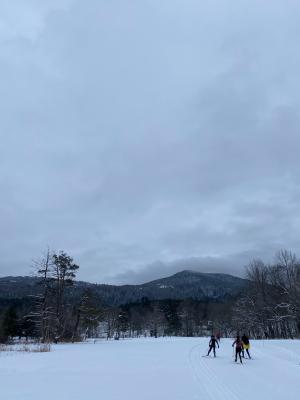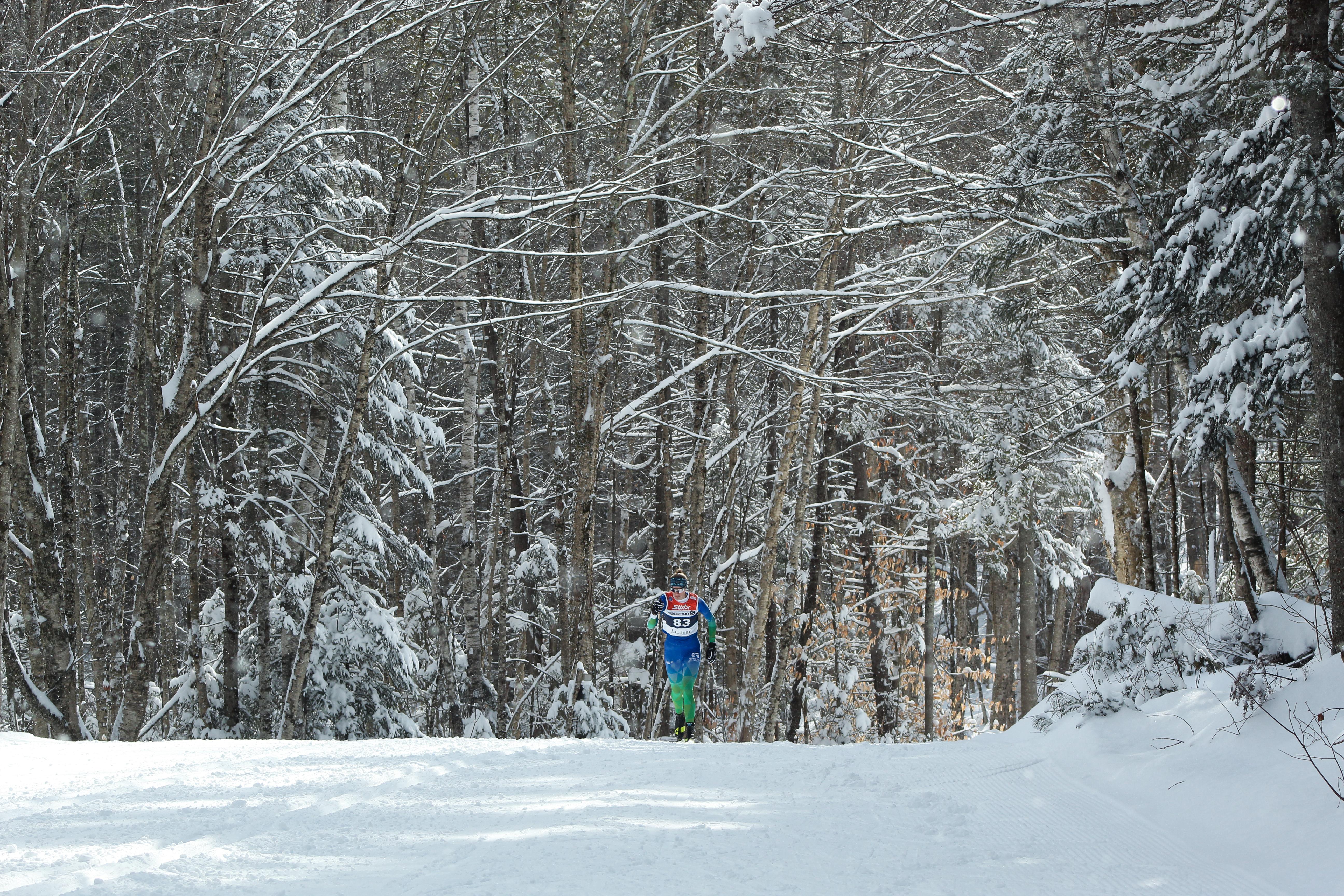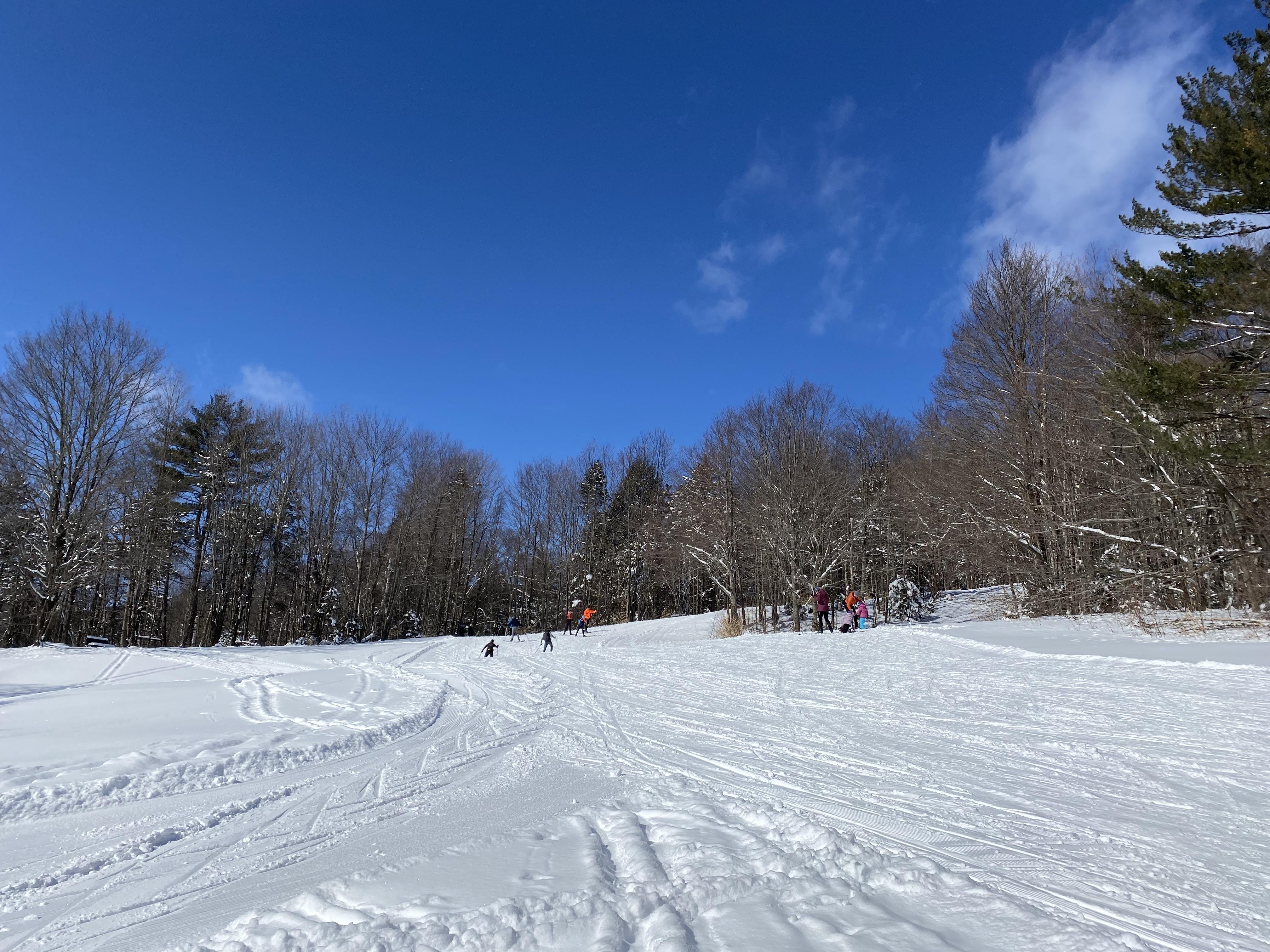- Tags:
- Climate,
- Recreation,
- Forest Journal

When Dublin Cross Country Ski Club coach, Kathy Maddock, was growing up in Massachusetts, there was only one ski center in the area making snow. In those days, New England winters could be relied upon to deliver on the one thing truly necessary to get out and ski: snow. Now, skiing in New England is starting to look a little different.
“You can’t plan on going out to your local golf course and go touring around the way we used to,” says Maddock, a Peterborough resident and former racer with the US National Team, “Now, if you want to survive in the cross-country ski world, you need to make snow. And if you’re a club, you have to have proximity to snowmaking or you really can’t be competitive.”
Cross-country, or Nordic, skiing has been part of New England’s winter sport culture for centuries. Performed by seamlessly gliding across snowy trails on long, narrow skis, the sport is well loved by all ages and abilities —an easy-going alternative to its more daredevil cousin, alpine skiing, perfect for anyone just trying to get out and enjoy the tranquility of a winter woods. But with recent changes in weather patterns, those winter woods are looking greener and greener by the year.

When I was in high school, racing under Maddock’s tutelage at Souhegan High in Amherst, golf courses and local town forests were often her choice practice location.
For skiers on that same team five years later, practices in the backfield have joined the ranks of other bygone skiing traditions. The team now must travel as far as Maddock’s new home ski center at the Dublin School in Dublin, NH.
“It’s been pretty inconsistent,” says Eric Fulton, a junior at Souhegan, skiing for their Nordic team since the seventh grade, “My first year on the team, by the time of our first race I had only skied on snow once.”
For individuals learning to ski, there are ways to bypass the need for snow. Dry land training methods such as hill-bounding techniques replicate movements needed to propel yourself up a snowy slope. Roller-skiing is a popular alternative to “real” skiing and can be performed on any flat and hard surface. But nothing can prepare you for actually skiing on snow like the real thing.
“Not everyone has the same access to snow,” says Fulton, “Souhegan hasn’t been on snow because there isn’t any. I think it gives a bit of an unfair advantage to some teams [further North] who have been on snow a couple of weeks before our first race.”
This gap in snow access is what inspired Bradford Bates, the head of the Dublin School, to first establish Dublin Cross Country Ski Club (DXC) in 2014, and then to begin making snow at the center in 2015.
“We wanted to have a Nordic center that was closer to Boston, so people from Massachusetts and Southern NH wouldn’t have to drive up to Craftsbury, VT [to get on good snow],” says Bates, an avid skier himself since childhood.
DXC, the first high school training center to be recognized by the International Ski Federation, has nine kilometers of trails on the West side of Dublin Road, and an additional 20 kms opposite. The nine km track is full of bending switchbacks and 800 vertical feet of climbing, making it an exciting and challenging course for young skiers to test their skills. It is, however, equally challenging for snowmakers.

The snowmakers at Dublin must contend not only with changing ground and air temperatures, but also varying amounts of tree cover, removing rocks from the trail, and maintaining a dry underlayer to prevent run off and excess melting. On top of all that, the trails they are working on are so complex that getting them sufficiently covered is an all-night affair.
“In Europe, they build one trail that works uphill, and another downhill trail, and then have snow making in just one area,” says Bates, “It’s not as exciting but it’s energy efficient. If we did it all over again, I’d probably design our Nordic center differently.”
Energy efficiency is at the forefront of Bates’ mind.
“We don’t want to be contributing to the problem,” he says.
The DXC ski center uses approximately 200,000 gallons of water a day to make enough snow to cover their man-made loop. But Bates has found ways to offset the operation’s carbon footprint. The school uses a solar field to power their alpine ski area and invests in top-of-the-line snowmaking equipment that is up to date on new energy efficiency standards. Bates also finds comfort in the fact that their snow making operation is improving skiing access for people who would usually have to drive hundreds of miles to get to snow.
“We’re hoping that cutting down on travel can offset the energy we’re using from making snow,” he says, “And we’re being more meticulous about the whole process in general.”
As snowmaking becomes more and more prominent, and in truth more necessary, Bates advises other ski centers to approach this process with similar intentionality.

“I think there’s going to have to be more snowmaking,” he says, “We all have to collaborate and share knowledge. That’s super important.”
The three skiers all share concern for the future of their beloved sport.
“I just can’t state strongly enough how sad it is to see important elements of the sport I love literally washing away,” says Kathy Maddock, “I want more people to start the sport, but I don’t feel great about telling someone to invest hundreds of dollars into equipment and then, actually, you might never get onto snow.”
Eric Fulton, who at 17 years old is hoping to continue skiing the rest of his life, says, “I know that when I move out, I’ll want to live somewhere cold that has snow. Of course, it might be more difficult for me to find a place like that in the future, since it’s been 60 degrees in December.”
New Hampshire’s climate has warmed 3 degrees F since 1901, according to the 2021 NH Climate Assessment from the Sustainability Institute at UNH. Fall and winter temperatures have increased the most during this time. Consequentially, the reported ice out dates (the point at which frozen bodies of water begin to thaw) recedes earlier and earlier, leaving us with smaller windows for beloved activities like ice fishing and pond skating.
At the time I am writing this, four days before Christmas, the ground outside my office window is orange with dead leaves. It grows increasingly hard to remember a Christmas that has been white.
Man-made snow can save our skiing, but it cannot save our climate, our ecology, the traditions and communities New Hampshire-ites have built around winter for centuries. More than just a season is at stake. It’s our way of life.
(A version of this ran in the Union Leader on December 31st)
